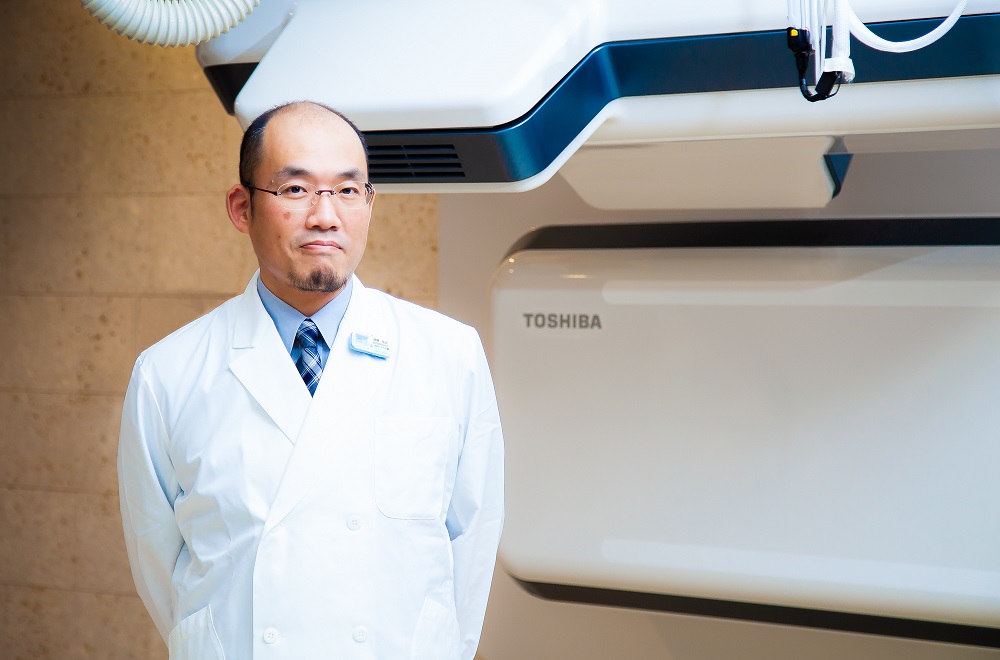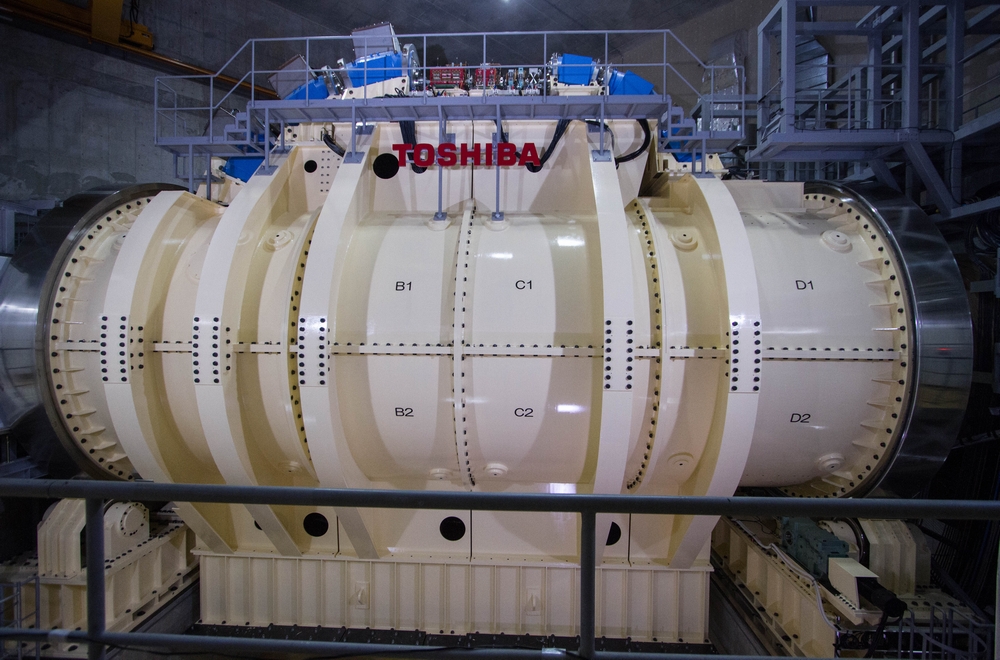The future of medicine set into motion by the Yamagata Model, a new cancer treatment technology: Taking on the challenge of global standardization of heavy ion therapy equipment
2022/07/20 Toshiba Clip Team
- Cancer treatment with the world's smallest rotating gantry began at Yamagata University in 2022.
- Lack of clinical experience and data posed obstacles. What is the breakthrough in the “mission to popularize heavy ion therapy”?
- The near-future vision is to push the “nichest of niche” treatments into the global mainstream.
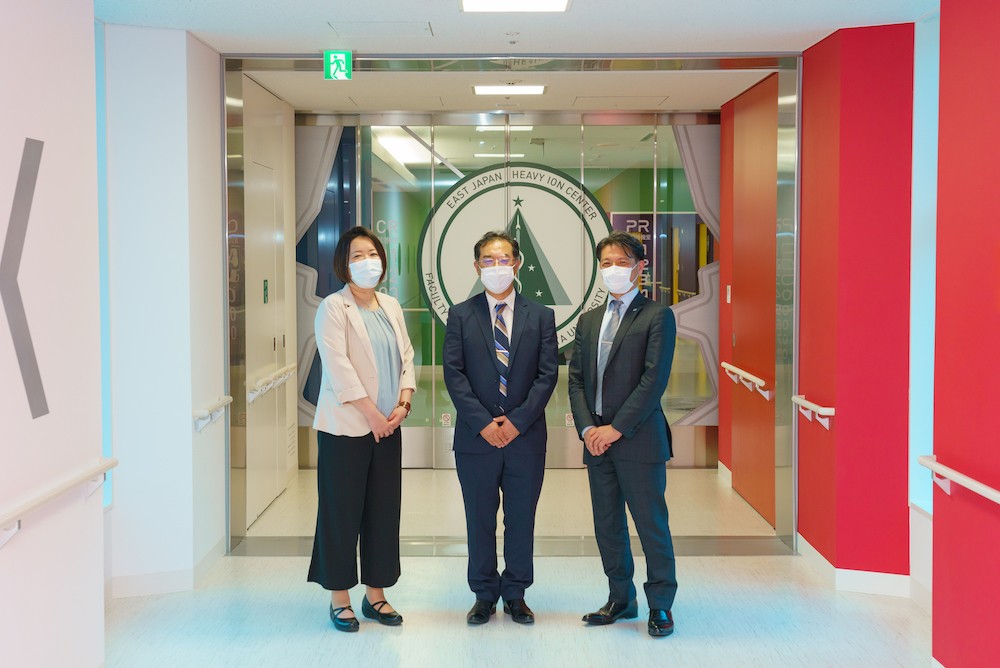
“Music plays in the treatment room, and it is a relaxing environment. If nobody had told me, I wouldn’t have known I was being irradiated. There’s no pain and the irradiation time is short, so I’m glad I’ve had the treatment.”
The comment is from a patient treated at the East Japan Heavy Ion Center, Faculty of Medicine at Yamagata University. As reported in Part 1 and Part 2 of this three-part series, the new facility opened on February 25, 2021, and two patients were treated that day. The Tohoku and Hokkaido regions had a new option for cancer treatment.
However, heavy ion therapy equipment is a rarity everywhere the world. In the words of Dr. Takeo Iwai, Deputy Director of the East Japan Heavy Ion Center, the man who oversaw all aspects of the installation of the equipment from the design stage on, “Heavy ion cancer therapy is the nichest of the niche.” With its many advantages, how can this equipment be made more widespread and take root in society? And what kind of developments could that lead to in the future of medicine? This article explores the outlook.
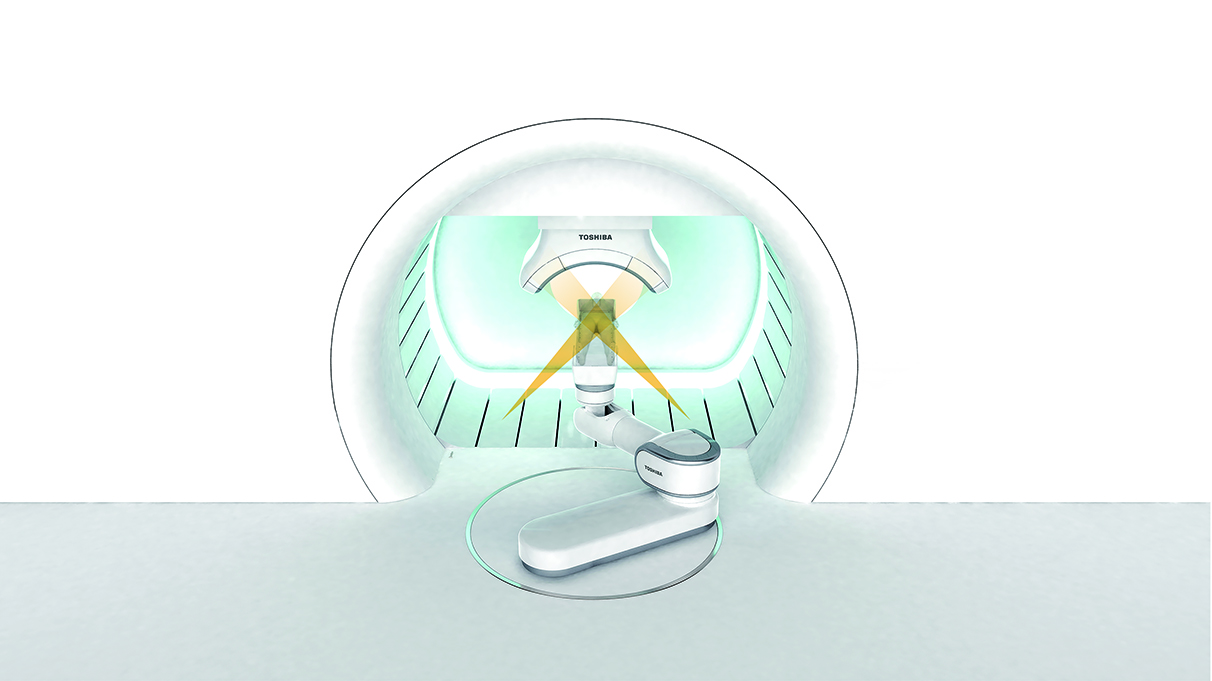
Heavy ion therapy equipment with the world’s smallest rotating gantry
In the face of fierce competition among major heavy electric machinery manufacturers, Toshiba delivered Japan’s first rotating gantry for heavy ion cancer therapy using superconducting technology to the National Institutes for Quantum Science and Technology QST Hospital in 2016. The gantry is the cylindrical, doughnut-like area where the patient receives treatment, and its 360-degree rotation allows precise beam irradiation from any angle, significantly expanding the scope of treatment. The East Japan Heavy Ion Center now has the world’s smallest rotating gantry, one even smaller than that of the QST Hospital, thanks to Toshiba’s technology.
“The successful track record of the rotating gantry at QST Hospital was a major factor,” says Iwai, explaining the selection of Toshiba. “Then there was hesitancy on the part of its competitors, who said it would be difficult to deliver to our schedule. The operation record and schedule were the deciding factors.”
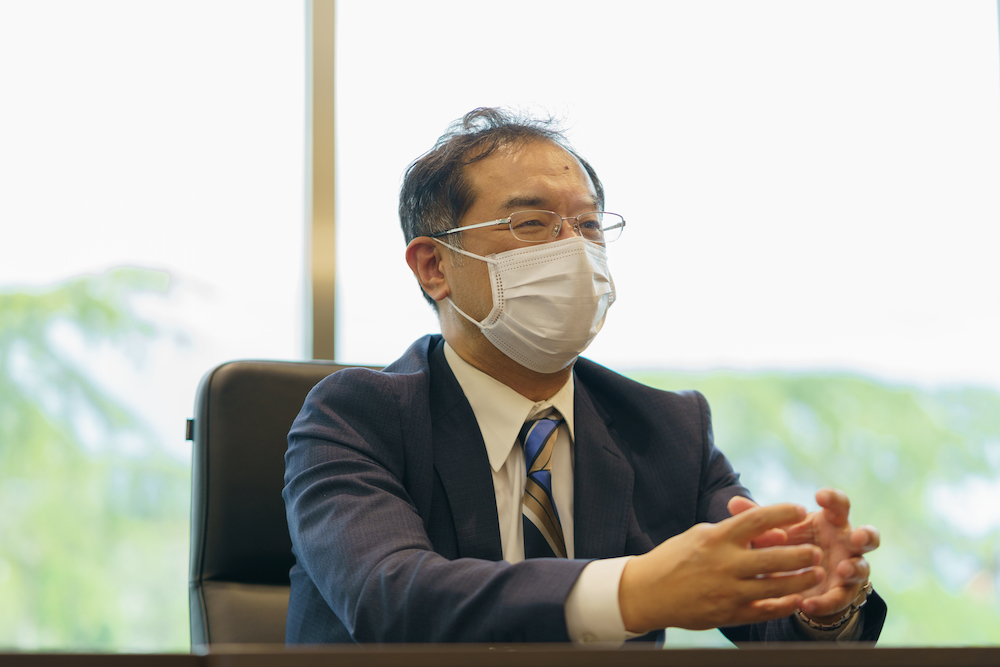
Dr. Takeo Iwai, Deputy Director, East Japan Heavy Ion Center, Faculty of Medicine, Yamagata University
Successfully making compact rotating gantry, achieving the world’s smallest size
The East Japan Heavy Ion Center has two treatment rooms: a fixed beam treatment room and a rotating gantry treatment room. The treatment launched in February 2021 covers prostate cancer, using the horizontal beam in the fixed beam treatment room. Things have progressed smoothly, and shortly after the start of operations, the new Center had more than 100 appointments, three times more than expected at that point. “First of all, I want to build a track record for treatment. Once the rotating gantry treatment room is up and running, the next goal is to get everything on track”, commented Iwai with enthusiasm.
Once the rotating gantry treatment room is in stable operation, cancers of the head and neck, bone and soft tissue, liver, and pancreas will also be targeted, and the number of target sites will be expanded as needed. However, as the number of sites that can be irradiated expands, so will the need to customize treatment for individual patients. That will have to be examined closely in the future.
Akira Yoshino of Toshiba Energy Systems & Solutions gives his honest thoughts: “Our focus in installing the rotating gantry was on achieving the world’s smallest size. Components are closer to each other than those in the rotating gantry at QST Hospital, and the structure and layout are more complex, but we made it through by making detailed adjustments. There is also no problem obtaining data from the equipment. We reached this point with the cooperation of our partner, B dot Medical*, who helped us with various technical issues from the design stage. Still, we won’t be able to shake off our concerns for some time after operation has begun.” Both anxiety and anticipation rose in the face of the lofty goal of achieving the world’s smallest size.
*A start-up company originating from the National Institute of Radiological Sciences, with advanced technology and various expertise cultivated there.
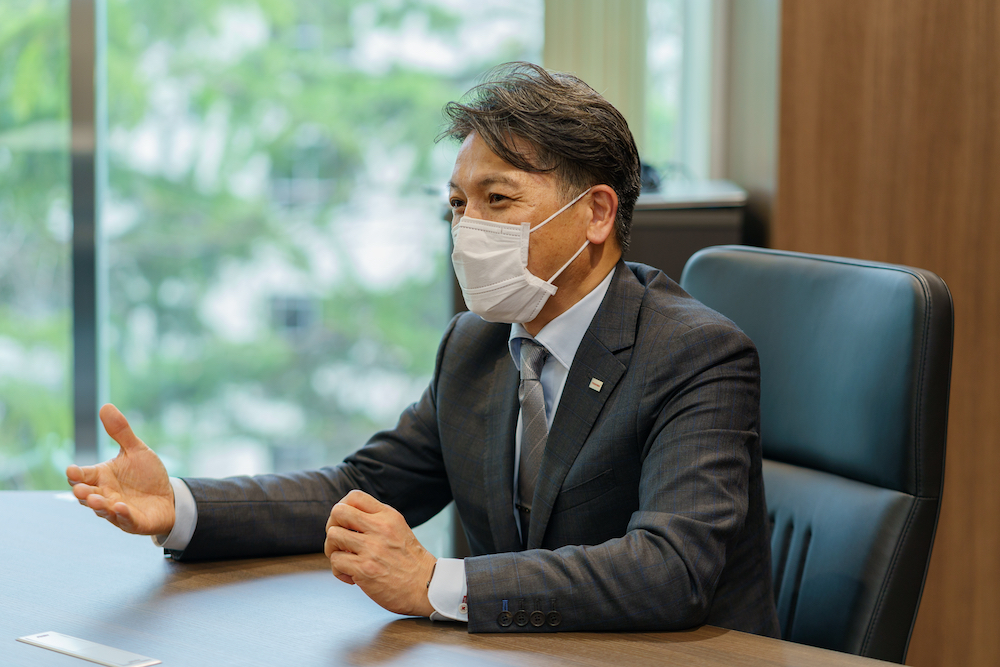
Akira Yoshino, former Senior Manager, Particle Radiotherapy Business Project Engineering Dept., Power Systems Div., Toshiba Energy Systems & Solutions Corporation
“The next goal is to make the Yamagata Model a global standard,” says Yoshino. “We are scheduled to deliver rotating gantries with the same design to Yonsei University and Seoul National University in South Korea, which have comprehensive international exchange agreements with Yamagata University’s Faculty of Medicine. As we accumulate clinical experience and start seeing results, we are confident that this equipment will be positively accepted; it will gain trust, and expectations will rise. We plan to refine it as we receive feedback from the treatment field,” says Yoshino.
The challenges that come with being at the cutting edge: A shortage of clinical trials proves to be a stumbling block to global expansion
Why is it that heavy ion therapy, with its many advantages for both doctors and patients, is not more widespread? Eri Takeshita of B dot Medical, who is also a doctor of science, points out that the number of clinical cases is low. “Heavy ion therapies have a shorter history than X-ray therapy, and still need refinement moving forward. That is precisely why East Japan Heavy Ion Center and others shall continue to accumulate clinical results and share their knowledge. Isn’t it the mission of users who have installed the equipment?”
“I sound quite pompous,” she laughs seemingly at herself. But this is probably her true feelings, having background of supporting the users as a former employee of the National Institute of Radiological Sciences, as well as understanding the manufacturer’s position with her track record in equipment manufacturing.

Eri Takeshita Ph.D., General Manager, R& D Department, B dot Medical Inc.
Unlike X-ray, heavy ion beam can be tailored to deliver ionization peaks* and higher energy to cancerous tumors, which means that they can destroy them while minimizing damage to normal cells. X-ray is most effective closer to the body’s surface and become weaker as they travel through the body, whereas heavy ion beam can irradiate cancer cells with pinpoint accuracy.
*The process whereby the energy of the radiation as it passes through a material repels the electrons (negative charge) of the atoms in the material and separates them into positively charged atoms and free electrons.
Takeshita notes that, “Taking full advantage of this characteristic requires a rotating gantry that is easy to operate and spins fast.” Toshiba’s fits the bill on both counts, and as Akira Yoshino of Toshiba Energy Systems & Solutions notes with pride, “In terms of rotation technology, we are almost at the point of achieving one goal, which is to irradiate cancer cells accurately.”
Installation is not the goal. Pushing own limits for further improvement
Heavy ion beam is emitted from the scanning irradiation equipment. There was quite a struggle with this part. Standard scanning irradiation equipment uses two scanning electromagnets that change their magnetics fields at high speed, causing the beam to scan in two orthogonal directions and irradiate the entire affected area. Toshiba achieved the same result with a single scanning electromagnet, utilizing coil winding manufacturing technology developed with Takuji Furukawa, the president of B dot Medical, and other researchers at the National Institutes for Quantum Science and Technology. The outcome of this innovation is that the distance from the equipment to the irradiation point, previously a 9m requirement, has been reduced to 3.5 m. This also helped to make the rotating gantry itself more compact.

Left: Comparison of scanning irradiation equipment size
Right: Comparison of rotating gantry size (illustration: this device, image in gray: conventional device)
By reducing the distance in this way, the East Japan Heavy Ion Center’s equipment had room left to extend the magnet itself. The magnet is in the shape of a trumpet. By extending it, the irradiation field, which is the end of the horn, from where the sound emerges, can be widened. The widened radiation field realized by this extended horn is adopted in the heavy ion therapy equipment scheduled for delivery to Seoul National University. When the clinical results are accumulated at Seoul National University, it may eventually be possible to expand the irradiation field at the East Japan Heavy Ion Center too. Trial and error confirmation to overcome difficulties faced with the Yamagata Model are surely paving the way to the future.
Heavy ion beams may be minor, but have more benefits than X-rays or proton beams
The team, which has achieved the world’s first and world’s smallest rotating gantry in quick succession has not ended its journey. It says it already has its eyes on next generation technology that combines the heavy ion therapy system with diagnostic imaging such as CT and MRI. The rotating gantry will be combined with CT and MRI to irradiate the actual cancer cells while viewing them. This is a technology that many doctors are calling for, even in cancer treatment with X-ray irradiation. “Whatever doctors want to do with X-ray therapy, they should also want to do with heavy ion therapy.” says Takeshita, explaining the actual circumstances.
“Heavy ion beams should provide more benefits than X-rays because they can irradiate cancer cells with pinpoint accuracy,” says Iwai. “Of course, there are cost obstacles in to adding MRI to the current system. But there’s no doubt that it will change the world of cancer treatment.
“Currently, insurance coverage for heavy ion cancer therapy covers three sites: the prostate, head and neck, and bone and soft tissue. By accumulating clinical trial data, we would like to contribute to the expert meeting of the Ministry of Health, Labor and Welfare, which is considering the scope of insurance coverage, and expand the sites under coverage as much as possible.”
X-ray treatment is the rival. Competing to become the major treatment
The conventional wisdom is that X-rays are the mainstream of cancer radiotherapy. To popularize heavy ion cancer therapy, clinical trials must demonstrate its superiority over X-rays.
“The foundation of radiotherapy is statistics. The medical field needs to accumulate data on the survival rate after 5 or 10 years and the incidence of side effects. We can’t contend in any way unless we gain the numbers. I think someone needs to take the lead in doing this on a global scale,” says Takeshita.
This calls for a user group that brings together facilities that have installed heavy ion therapy equipment to exchange opinions. “There is a need to hear real voices from the user’s perspective on topics like what the future holds for heavy ion cancer therapy, and what kind of technological development is needed,” she says. “Toshiba is growing its customer base both in Japan and internationally. Medical physicists interact with each other, and so do doctors. There should be no resistance to a gathering and discussions among representatives from Yamagata University, Seoul National University, and Yonsei University. We should make good use of this platform for exchanges of ideas and seize the opportunity.”
QST Hospital and other facilities that have installed heavy ion therapy equipment are conducting a series of clinical trials as part of the “Japan Carbon-ion Radiation Oncology Study Group Trial.” The East Japan Heavy Ion Center is also reportedly planning to begin clinical trials for liver and pancreatic cancer once the rotating gantry is in stable operation.
They are aiming to move away from the “nichest of niche” to popularize heavy ion cancer therapy.
* Note: Departments and titles are as at the time of interviews.
![]()
Related Links
*This section contains links to websites operated by companies and organizations other than Toshiba Corporation.
Heavy Ion Therapy | Toshiba Energy Systems & Solutions
https://bdotmed.co.jp/en/





